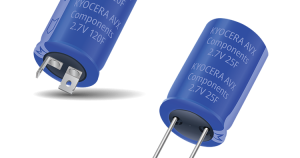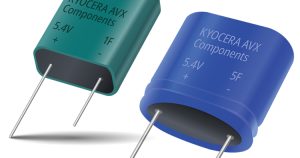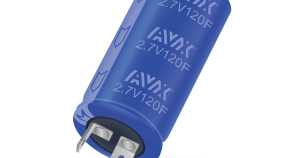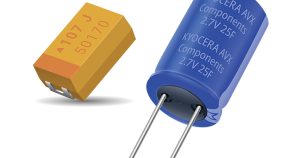Safety Considerations for Acetonitrile SuperCapacitors Written By: Akihiro Kado Abstract: Advancements in SuperCapacitor design and manufacturing have made them a mainstay component in power supplies and backup systems that require high power density output. SuperCapacitors have now become commonplace components in many areas of modern electronic design. They bridge an important gap between batteries – used for high density energy storage, and electronic capacitors – for local power supply stabilization and decoupling. SuperCapacitors offer the unique ability to provide large amounts of power for short periods of time. For this reason, they have found a home in applications such as electric vehicles, uninterruptible power supplies, and data storage devices. A wide variety of SuperCapacitor structures and materials have been developed,
SuperCapacitors
Advantages of SuperCapacitors for Power Constrained Backup Written By: Johnson Jiang Abstract: In most energy storage scenarios, the tradeoffs between power density and energy density quickly come to the foreground. This is best illustrated in the automotive industry, where power density directly translates to acceleration and driving performance, while energy density translates to the total range achievable on a tank of gas or, for an electric vehicle, on a single recharge cycle. This is true across almost every application, from wearable electronics to microgrid power networks on a college campus. This whitepaper from KYOCERA AVX will explore the advantages of SuperCapacitors, circuit level, uninterruptable power, and microgrid considerations, and the benefits that make them a more reliable option than traditional
SuperCapacitor Improvements on Small Generator Power Quality Written By: Ron Demcko | Ashley Stanziola | Daniel West Abstract: To expand portable electronics usage/reach/offering, the renewable power industry has taken an interest in the worldwide awareness of climate change and electronic waste, specifically how batteries affect the environment. One advancement is the emergence of modern low power hand crank generators, which roughly coincides with the accelerating interest in green energy used in portable electronics.
SuperCapacitors: A Reliable Backup Power Solution Written By: Johnson Jiang Abstract: Electric double-layer capacitors (EDLCs) are electrochemical capacitors called “SuperCapacitors,” or supercaps, due to their high energy density. Compared to traditional electrolytic capacitors, SuperCapacitors store electrical energy about two to three orders of magnitude higher and achieve several hundred thousand to millions of charge-discharge cycles. This advantage comes from the special construction of SuperCapacitors.
SuperCapacitors in Enterprise Servers and Smart Meters Written By: Jacky Cui | John Lee Abstract: The supercapacitor is one alternative to the traditional electrochemical battery for storing energy. In the age of lithium-ion (Li-ion) batteries, supercapacitors offer many attractive properties that no other device can deliver. At a high level, supercapacitors are composed of electrodes, an electrolyte, and an ion-permeable separator.
Using SuperCapacitors in Electric Vehicles Written By: Adrian Thomas Abstract: The improved performance and practicality of electric vehicles (EVs) have merited them a permanent foothold in the overall automotive market. When combined with geo-political and environmental initiatives, it is clear that the demand for EVs will continue to increase long into the future.
Tantalum and SuperCapacitors Enable Maintenance Free Microcontrollers Written By: Ron Demcko | Daniel West | Ashley Stanziola Abstract: Ultra-low-power microcontroller families now exist with such low power requirements that they can be powered by energy harvesting rather than battery-operated or conventional mains. These powerful MCUs enable maintenance-free control systems in applications ranging from structure/soil/water/air monitoring applications to industrial point controllers (such as smart faucets) to wearable electronics, location tracking, and even BLE beacons.
Powering IoT Modules Using Solar Panels, SuperCapacitors, and an Automatic Buck/Boost Controller IC Written By: Ron Demcko | Ashley Stanziola | Daniel West Abstract: The use of IoT modules is exhibiting a high rate of growth because of their low cost, ease of implementation, and easily documented impact upon end-user efficiency, reliability, and cost. Manufacturers, installers, and end-users of IoT modules are seeking ways to power these devices and essentially create a set-and-forget module. Set-and-forget means a significant ongoing effort to eliminate batteries or extend the life of batteries powering IoT modules. Manufacturers of IoT modules are working to reduce their designs’ power consumption and also working with IC suppliers by requesting novel chipsets to provide quality power from harvested
Reliability of SuperCapacitors: Long-Term Reliability Test Data (Part 2) Written By: Eric DeRose | Bob Knopsnyder | Bharat Rawal Abstract: Extensive testing of electronic components is required for an understanding of their device physics, their degradation behavior and their failure mechanisms for establishing their longterm reliability. Gaining a better understanding of part characteristics results in the utilization of the right part which can be recommended to customers depending on the application’s operating conditions such as voltage, temperature and relative humidity. Samples of all products produced are evaluated and tested for up to 4,000 hours to establish reliability test data. As we strive to be an industry leader in reliability of our supercapacitors or electric double-layer capacitors, we do our due
Reliability of SuperCapacitors: Unique Performance at 85°C & Self-Balancing (Part 1) Written By: Eric DeRose | Bob Knopsnyder | Bharat Rawal Abstract: Increasing use of supercapacitors on printed circuit boards (PCBs) is requiring a further understanding of the reliability of these components. As the use of these types of devices increases, the emphasis on reliability will become critical as sub-ppm failure rates are critical for minimizing and, in fact, eliminating rework of the PCBs in these applications. A broader understanding of the reliability of these devices will assist in reaching this goal. In this first of many publications, a study of our supercapacitor modules tested at 85°C at various applied voltages, at or below the rated voltage, will demonstrate the
Charge Control Methods for SuperCapacitors: Methods to Protect Power Sources from Damage Due to High Current Demands of SuperCapacitors Written By: Ron Demcko | Joe Hock | Ashley Stanziola | Daniel West Abstract: Circuit designs exploiting the increased energy storage provided by supercapacitors, requires careful consideration of the increased power handling, than that of batteries, when charging these devices. The unique composition of electrochemical double-layer capacitors (EDLC) inherently allows them to withstand large currents. Table 1 below is a brief list of AVX cylindrical (SCC) and series-connected module (SCM) SuperCapacitors, displaying peak current supply and sink current capability. These maximum specifications will typically exceed current capability of charge sources, and lead to failures within the power supply system. Supercapacitors have
BestCap®: A New Dimension in “Fast” SuperCapacitors Written By: Scot Tripp | Dr. Arieh Meitav Abstract: Supercapacitors or electrochemical caps are rapidly recognized as an excellent compromise between electronic capacitors such as ceramic, tantalum and aluminum electrolytic devices and batteries. Generally, supercapacitors have energy densities several orders of magnitude higher than electronic capacitors (Table 1) and power densities significantly superior to batteries. There are, however, two negative characteristics associated with existing electrochemical capacitors, high ESR and capacitance loss when called upon to supply very short duration pulses at high current. This paper will demonstrate how the BestCap® successfully addresses both of these issues.
BestCap®: A New Generation of Pulse Double Layer Capacitors Written By: Bharat Rawal | Lee Shinaberger Abstract: BestCap®, a new generation of Double Layer Capacitors (DLCs) have been developed to deliver low ESR, high power pulses, or provide back-up power in some applications. These capacitors have values of 10 to 560 mF, voltage ratings of 3.5 to 12 volts and ESR values of 20 to 500 mW. This paper describes the electrical properties of the BestCap® and it’s endurance under different environmental conditions. Specific applications are shown for illustrative purposes.
BestCap®: A New Generation of Low Voltage, Low ESR, Pulse, Double Layer Capacitors Written By: Lee Shinaberger | Bharat Rawal | Chris Reynolds Abstract: Electrochemical double layer capacitors (EDLCs) produced for back up applications in the last twenty-five years had high Equivalent Series Resistance (ESR) and high loss of capacitance when used in pulse power applications. In addition, the voltages of these devices were limited to less than 5 volts. In 2000, AVX introduced the BestCap® line of capacitors to address these limitations to serve the high pulse power market. This paper will present capabilities and subsequent improvements to the BestCap® product line.
Enhancing Cellphone Battery Performance During GSM Pulses Through the Use of a Parallel SuperCapacitor Written By: Ron Demcko | Patrick German Abstract: With the constant addition of features and functionality, battery life and reliability are becoming increasingly vital to those who rely on their smartphones. The transmission signal requires quick pulses of current from the battery, potentially causing the instantaneous voltage of the battery to drop below the phone’s minimum voltage of operation. This may cause the power to the battery to be temporarily interrupted. A series of tests were performed on multiple battery chemistries to determine the beneficial effect of placing an AVX supercapacitor in parallel with the battery, to improve the life of the battery as well as






